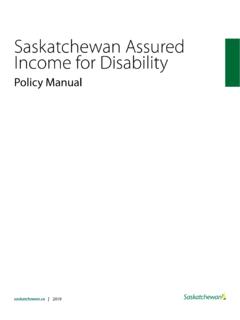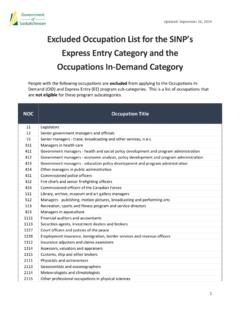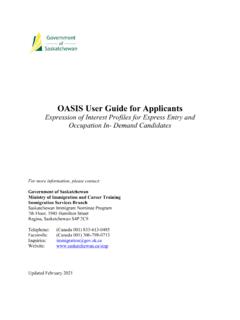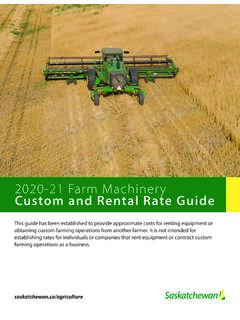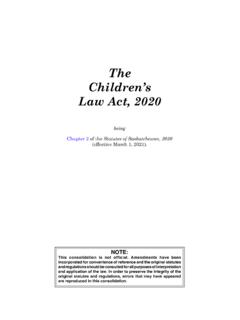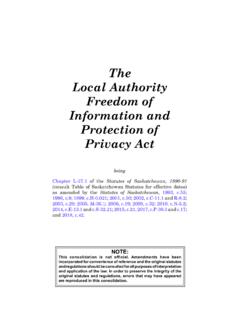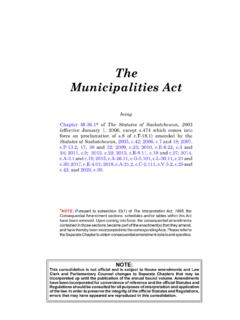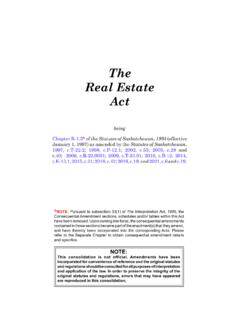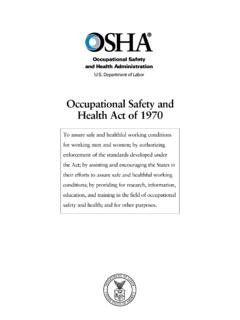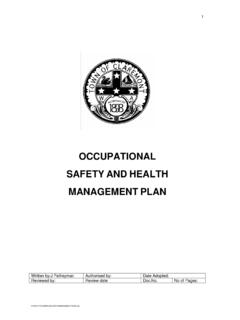Transcription of The Occupational Health and Safety Regulations, 2020
1 1 Occupational Health AND Safety , REG 10 The Occupational Health and Safety regulations , 2020beingChapter Reg 10 (effective April 1, 2021) as amended by Saskatchewan regulations 31 :This consolidation is not official. Amendments have been incorporated for convenience of reference and the original statutes and regulations should be consulted for all purposes of interpretation and application of the law. In order to preserve the integrity of the original statutes and regulations , errors that may have appeared are reproduced in this Health AND Safety , REG 10 Table of ContentsPART 1 Preliminary Matters1-1 Title1-2 Definitions and Interpretation1-3 Giving notice to ministry1-4 Generality of duties not limited1-5 Certification by professional engineerPART 2 Notice Requirements2-1 New operations2-2 Accidents causing serious bodily injury2-3 Dangerous occurrences2-4 Medical information2-5 Report re injuriesPART 3 General Duties3-1 General duties of employers3-2 General duties of workers3-3 Employment of young persons3-4 Duty of employer or contractor to provide information3-5 Duty of contractor to inform3-6 Supervision of work3-7 Duty to inform workers3-8 Training of workers3-9 Workers contacts with officers3-10 Biological monitoring3-11 Occupational Health and Safety program3-12 Examination of plant3-13 Identifying mark of approved
2 Equipment3-14 Maintenance and repair of equipment3-15 Boilers and pressure vessels3-16 Prohibition re use of compressed air3-17 Inspection of place of employment3-18 Investigation of certain accidents3-19 Prohibition re scene of accident3-20 Investigation of dangerous occurrences3-21 Injuries requiring medical treatment3-22 Work where visibility is restricted3-23 Work or travel on ice over water, Working alone or at isolated place of employment3-25 Harassment3-26 Violence3-27 Safety measures retail premisesPART 4 Committees and Representatives4-1 Committees at construction sites4-2 Designation of committee members4-3 Quorum and certain votes4-4 Frequency of meetings4-5 Minutes4-6 Co-chairpersons4-7 Special meetings4-8 Designation of representative4-9 Training of representatives.
3 Committee members4-10 Meetings of employers and representatives4-11 Opportunity for necessary activities4-12 Meetings called by officerPART 5 First Aid5-1 Definitions for Part5-2 Application5-3 Provision of first aid5-4 More than 1 employer5-5 First aid personnel5-6 Certificates5-7 First aid station5-8 First aid register5-9 First aid room5-10 Workers being transported5-11 First aid supplies and equipment5-12 Transportation of injured workers5-13 Asphyxiation and poisoning5-14 Additional provisionsPART 6 General Health Requirements6-1 Sanitation6-2 Ventilation and air supply6-3 Mechanical ventilation6-4 Cleaning and maintaining ventilation systems6-5 Space6-6 Lighting6-7 Thermal conditions6-8 Toilet facilities6-9 Personal washing6-10 Clothing6-11 Change and sh ower facilities6-12 Eating areas6-13 Drinking water6-14 Smoking6-15 Lifting and handling loads6-16 Standing6-17 Sitting6-18 Musculoskeletal injuries6-19 Shift work and constant effort and exertion6-20 Visually demanding tasks6-21 Radioactive substances6-22 Exposure control Special vaccination leavePART 7 Personal Protective Equipment7-1 Use of equipment required7-2 General responsibilities7-3 Respiratory protective devices7-4 Inspection of respiratory protective devices7-5 Working in dangerous atmospheres7-6 Protective headwear7-7 Workers using all terrain vehicles, snowmobiles.
4 Eye and face protectors7-9 Skin protection7-10 Lower body protection7-11 Footwear7-12 Hand and arm protection7-13 Exposure to hazardous substances7-14 Exposure to noise7-15 Lifelines7-16 Personal fall arrest systems7-17 Full-body harness7-18 Snap hooks on personal fall arrest system7-19 Lanyards7-20 Workers responsibilities re lifelines, Inspection of full body harness, Protection against drowningPART 8 Noise Control and Hearing Conservation8-1 General duty8-2 Noise reduction through design, construction of buildings3 Occupational Health AND Safety , REG 108-3 Measurement of noise levels8-4 Hearing protection required8-5 Daily exposure greater than 85 dBA Lex8-6 Hearing conservation planPART 9 Safeguards, Storage, Warning Signs and Signals9-1 Definition for Part9-2 Protection against falling9-3 Fall protection plan9-4 Control zone9-5 Anchor Points and Anchor Plates9-6 Elevated conveyors9-7 Wire mesh9-8 Protection against falling objects9-9 Protection from objects falling from scaffolds, Handrails9-11 Guardrails9-12 Toeboards9-13 Openings in floors, roofs, Building shafts9-15 Safety nets9-16 Storage tanks9-17 Mounting of tires9-18 Storage of materials9-19 Pallets and storage racks9-20 Pressurized hoses9-21 Designated signallers9-22 Risk from vehicular trafficPART 10 Machine Safety10-1 Operation by workers10-2 Operating controls10-3 Unattended and suspended machines10-4 Safeguards10-5 Warning systems10-6 Locking out10-7 Cleaning, etc.
5 , of machine or other equipmentin motion10-8 Belts10-9 Air-actuated fastening tools10-10 Explosive-actuated fastening tools10-11 Airless spray units10-12 Grinding machines10-13 Chain saws10-14 Circular saws10-15 Power-fed circular saws10-16 Band-saws10-17 Cut-off saws10-18 Pushblocks and pushsticks10-19 Hand-fed planers and joinersPART 11 Powered Mobile Equipment11-1 Definition for Part11-2 Trained operators for powered mobile equipment11-3 Visual inspection11-4 Inspection and maintenance11-5 Requirements for powered mobile equipment11-6 Construction, repair, etc., of poweredmobile equipment11-7 Use of seat-belt or restraint by operator11-8 Protection against shifting of load11-9 Warning of reverse motion11-10 Roll-over protective structures11-11 Transparent materials used in cabs, Fuel tanks in enclosed cabs11-13 Dangerous movements11-14 Transporting workers11-15 Ladders attached to extending boom11-16 ForkliftsPART 12 Scaffolds, Aerial Devices, Elevating Work Platforms and Temporary Supporting Structures12-1 Definitions for Part12-2 Scaffold required12-3 Prohibition12-4 Limited use of certain scaffolds12-5 General requirements12-6 Ropes in scaffolds12-7 Scaffold planks and platforms12-8 Wooden scaffolds12-9 Metal scaffolds12-10 Heavy-duty scaffolds.
6 Scaffolds used atcertain heights12-11 Half-horse scaffolds12-12 Bracket scaffolds12-13 Ladderjack scaffolds12-14 Single-pole scaffolds12-15 Outrigger scaffolds12-16 Suspended scaffolds12-17 Suspended powered scaffolds12-18 Tie-in guides12-19 Use of suspended powered scaffolds12-20 Workers responsibilities12-21 Rolling scaffolds12-22 Shinglers roofing scaffold12-23 Crawl boards, roof ladders12-24 Prohibition12-25 Aerial devices and elevating work platforms12-26 Maintenance and inspection12-27 Forklifts12-28 Temporary supporting structures12-29 Flyform deck panels12-30 Erection of masonry wall12-31 Erection of skeleton structurePART 13 Hoists, Cranes and Lifting Devices13-1 Definitions for Part13-2 Application of Part13-3 General requirements13-4 Adoption of standards13-5 Load ratings13-6 Designated operator13-7 Operating procedures13-8 Rated load13-9 Raising and lowering workers13-10 Determining weight of load13-11 Overload switches13-12 Designated signaller13-13 General requirements for cranes and hoists 13-14 Hoists, cranes with outriggers, Operators cabs on tower cranes13-16 Erecting and dismantling13-17 Log book13-18 Inspections13-19 Repairs13-20 Friction type hoists13-21 Material hoists13-22 Tower hoists13-23 Roofers hoists13-24 Vehicle hoists13-25 Manually-operated hoists13-26 Winches13-27 A-frames and gin poles13-28 Pile-driving equipment4 Occupational Health AND Safety .
7 REG 10 PART 14 Rigging14-1 Definitions for Part14-2 General requirements14-3 Inspection14-4 Maximum loads14-5 Slings14-6 Shackles14-7 Sheaves, spools and drums14-8 Knots, wire rope clips14-9 Eye loops14-10 Hooks14-11 Wedge sockets14-12 Wire rope14-13 Rotation or motion of loadPART 15 Robotics15-1 Definitions for Part15-2 Application of Part15-3 Safe work practices and procedures15-4 General requirements15-5 Safeguards15-6 Controls15-7 Protection during maintenance or repair15-8 Protection during teachingPART 16 Entrances, Exits and Ladders16-1 General duty re entrances, exits16-2 Doors16-3 Travelways16-4 Stairs16-5 Ladders16-6 Portable ladders16-7 Use of portable ladders16-8 Fixed ladders16-9 Construction laddersPART 17 Excavations, Trenches, Tunnels and Excavated Shafts17-1 Definitions for Part17-2 Application of Part17-3 Locating underground pipelines, Excavating and trenching17-5 Temporary protective structures17-6 Protection against cave-in of excavations17-7 Protection against cave-in of trenches17-8 Excavated shafts and tunnels17-9 Boreholes, belled areas of excavated shaftsPART 18 Confined Space Entry18-1 Definitions for Part18-2 Identification of confined spaces, hazards.
8 Avoidance of entry into hazardous confined space18-4 Requirements before confined space is entered18-5 Requirements before hazardous confinedspace is entered18-6 Notice if no hazard found18-7 Entry plan18-8 Purging and ventilating of unsafe atmosphere18-9 Precautions if safe atmosphere not possible18-10 Piping discharging hazardous substancesPART 19 Work in Compressed Air19-1 Definitions for Part19-2 Application of Part19-3 Before work in compressed air begins19-4 Workers in working chamber19-5 Standards for air19-6 Maximum air pressure19-7 Working periods and rest periodsPART 20 Diving Operations20-1 Definitions for Part20-2 Competent workers20-3 Standards20-4 Medical examination20-5 Diving supervisor20-6 Minimum crew20-7 Standby diver20-8 Diver s tender20-9 Breathing gas20-10 Diving equipment20-11 Equipment for diving base20-12 Hyperbaric chamber20-13 Diving plan20-14 General responsibilities of diver20-15 Diver s personal log20-16 Buddy system20-17 Free swimming diving20-18 Scuba diving20-19 Surface-supply divingPART 21 Chemical and Biological Substances21-1 General duties of employers21-2 List of chemical and biological substances21-3 Precautions for certain substances21-4 Substances listed in Table 1621-5 Substances listed in Table 1721-6 Substances listed in Table 1821-7 Protection of certain workers21-8 Respiratory protective devices21-9 Accumulations, spills and leaks21-10 Report of worker s exposure21-11 Emergency showers21-12 Eye flushing equipment21-13 Flammable, unstable.
9 Highly reactive andcorrosive substancesPART 22 Workplace Hazardous Materials Information System22-1 Definitions for Part22-2 Certain products exempted22-3 Restriction on use of hazardous products22-4 Worker education and training22-5 Supplier label22-6 Workplace label for employer produced products22-7 Workplace label for decanted products22-8 Identification of hazardous products inpiping systems and vessels22-9 Placard identifiers22-10 Laboratory and sample labels22-11 Supplier Safety data sheets22-12 Employer Safety data sheets22-13 Availability of Safety data sheets22-14 Omissions from Safety data sheet22-15 Disclosure re claim for exemption,exemption granted5 Occupational Health AND Safety , REG 10 PART 23 Asbestos23-1 Definitions for Part23-2 Application of Part23-3 Prohibition re crocidolite23-4 Prohibition re spraying23-5 Identification of asbestos-containing materials23-6 Labelling, placarding, Inspection23-8 Asbestos processes23-9 Asbestos surfaces23-10 Ventilation equipment23-11 Personal protective equipment23-12 Asbestos waste23-13 Warning of Health risks23-14 Training23-15 High risk asbestos processes23-16 Medical examinationsPART 24 Silica Processes and Abrasive Blasting24-1 Definitions for Part24-2 Application of Part24-3 Warning of workers24-4 Cleaning of blasting equipment.
10 Cleaning of worksites24-6 Silica processes other than abrasive blasting24-7 Isolation from air containing dust24-8 Personal protective equipment24-9 Standards for blasting enclosures24-10 Use of blasting enclosures24-11 Sandblasting24-12 Silica flour24-13 Medical examinationsPART 25 Fire and Explosi
